Renao Yan
One-Shot Neural Architecture Search with Network Similarity Directed Initialization for Pathological Image Classification
Jun 17, 2025Abstract:Deep learning-based pathological image analysis presents unique challenges due to the practical constraints of network design. Most existing methods apply computer vision models directly to medical tasks, neglecting the distinct characteristics of pathological images. This mismatch often leads to computational inefficiencies, particularly in edge-computing scenarios. To address this, we propose a novel Network Similarity Directed Initialization (NSDI) strategy to improve the stability of neural architecture search (NAS). Furthermore, we introduce domain adaptation into one-shot NAS to better handle variations in staining and semantic scale across pathology datasets. Experiments on the BRACS dataset demonstrate that our method outperforms existing approaches, delivering both superior classification performance and clinically relevant feature localization.
Can We Simplify Slide-level Fine-tuning of Pathology Foundation Models?
Feb 28, 2025Abstract:The emergence of foundation models in computational pathology has transformed histopathological image analysis, with whole slide imaging (WSI) diagnosis being a core application. Traditionally, weakly supervised fine-tuning via multiple instance learning (MIL) has been the primary method for adapting foundation models to WSIs. However, in this work we present a key experimental finding: a simple nonlinear mapping strategy combining mean pooling and a multilayer perceptron, called SiMLP, can effectively adapt patch-level foundation models to slide-level tasks without complex MIL-based learning. Through extensive experiments across diverse downstream tasks, we demonstrate the superior performance of SiMLP with state-of-the-art methods. For instance, on a large-scale pan-cancer classification task, SiMLP surpasses popular MIL-based methods by 3.52%. Furthermore, SiMLP shows strong learning ability in few-shot classification and remaining highly competitive with slide-level foundation models pretrained on tens of thousands of slides. Finally, SiMLP exhibits remarkable robustness and transferability in lung cancer subtyping. Overall, our findings challenge the conventional MIL-based fine-tuning paradigm, demonstrating that a task-agnostic representation strategy alone can effectively adapt foundation models to WSI analysis. These insights offer a unique and meaningful perspective for future research in digital pathology, paving the way for more efficient and broadly applicable methodologies.
Diagnostic Text-guided Representation Learning in Hierarchical Classification for Pathological Whole Slide Image
Nov 16, 2024



Abstract:With the development of digital imaging in medical microscopy, artificial intelligent-based analysis of pathological whole slide images (WSIs) provides a powerful tool for cancer diagnosis. Limited by the expensive cost of pixel-level annotation, current research primarily focuses on representation learning with slide-level labels, showing success in various downstream tasks. However, given the diversity of lesion types and the complex relationships between each other, these techniques still deserve further exploration in addressing advanced pathology tasks. To this end, we introduce the concept of hierarchical pathological image classification and propose a representation learning called PathTree. PathTree considers the multi-classification of diseases as a binary tree structure. Each category is represented as a professional pathological text description, which messages information with a tree-like encoder. The interactive text features are then used to guide the aggregation of hierarchical multiple representations. PathTree uses slide-text similarity to obtain probability scores and introduces two extra tree specific losses to further constrain the association between texts and slides. Through extensive experiments on three challenging hierarchical classification datasets: in-house cryosectioned lung tissue lesion identification, public prostate cancer grade assessment, and public breast cancer subtyping, our proposed PathTree is consistently competitive compared to the state-of-the-art methods and provides a new perspective on the deep learning-assisted solution for more complex WSI classification.
Agent Aggregator with Mask Denoise Mechanism for Histopathology Whole Slide Image Analysis
Sep 18, 2024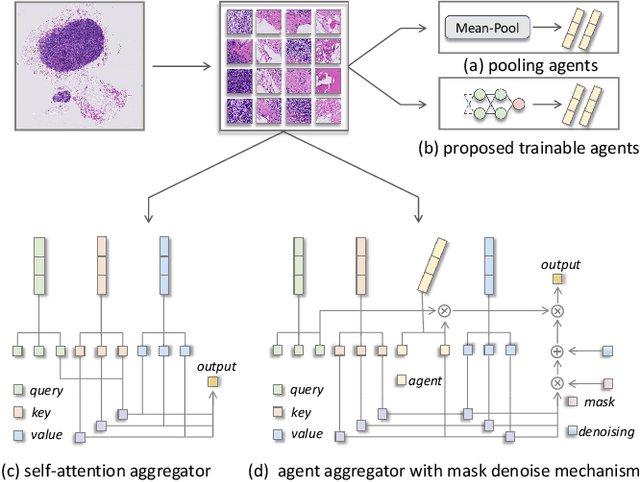
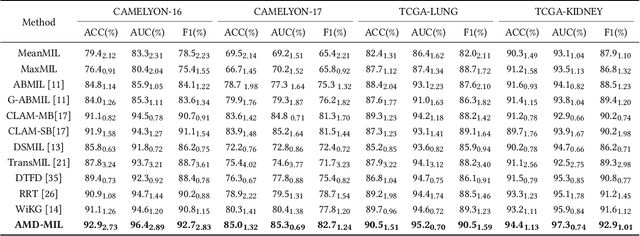
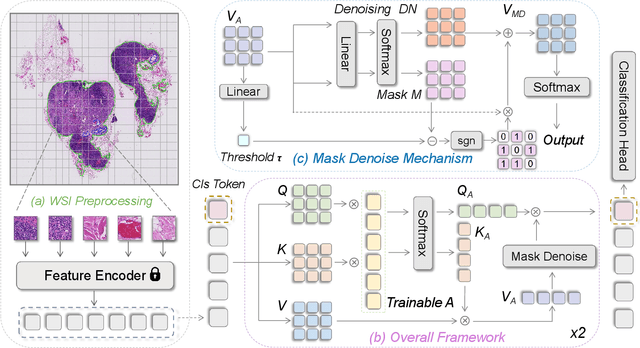
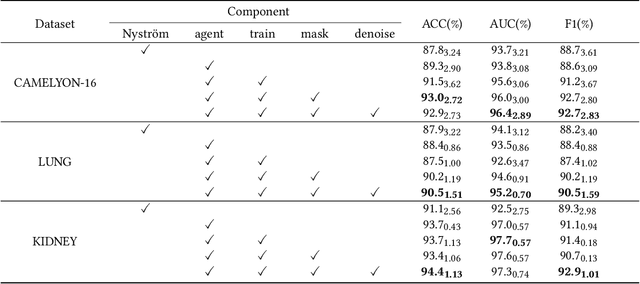
Abstract:Histopathology analysis is the gold standard for medical diagnosis. Accurate classification of whole slide images (WSIs) and region-of-interests (ROIs) localization can assist pathologists in diagnosis. The gigapixel resolution of WSI and the absence of fine-grained annotations make direct classification and analysis challenging. In weakly supervised learning, multiple instance learning (MIL) presents a promising approach for WSI classification. The prevailing strategy is to use attention mechanisms to measure instance importance for classification. However, attention mechanisms fail to capture inter-instance information, and self-attention causes quadratic computational complexity. To address these challenges, we propose AMD-MIL, an agent aggregator with a mask denoise mechanism. The agent token acts as an intermediate variable between the query and key for computing instance importance. Mask and denoising matrices, mapped from agents-aggregated value, dynamically mask low-contribution representations and eliminate noise. AMD-MIL achieves better attention allocation by adjusting feature representations, capturing micro-metastases in cancer, and improving interpretability. Extensive experiments on CAMELYON-16, CAMELYON-17, TCGA-KIDNEY, and TCGA-LUNG show AMD-MIL's superiority over state-of-the-art methods.
MergeUp-augmented Semi-Weakly Supervised Learning for WSI Classification
Aug 23, 2024



Abstract:Recent advancements in computational pathology and artificial intelligence have significantly improved whole slide image (WSI) classification. However, the gigapixel resolution of WSIs and the scarcity of manual annotations present substantial challenges. Multiple instance learning (MIL) is a promising weakly supervised learning approach for WSI classification. Recently research revealed employing pseudo bag augmentation can encourage models to learn various data, thus bolstering models' performance. While directly inheriting the parents' labels can introduce more noise by mislabeling in training. To address this issue, we translate the WSI classification task from weakly supervised learning to semi-weakly supervised learning, termed SWS-MIL, where adaptive pseudo bag augmentation (AdaPse) is employed to assign labeled and unlabeled data based on a threshold strategy. Using the "student-teacher" pattern, we introduce a feature augmentation technique, MergeUp, which merges bags with low-priority bags to enhance inter-category information, increasing training data diversity. Experimental results on the CAMELYON-16, BRACS, and TCGA-LUNG datasets demonstrate the superiority of our method over existing state-of-the-art approaches, affirming its efficacy in WSI classification.
Task-oriented Embedding Counts: Heuristic Clustering-driven Feature Fine-tuning for Whole Slide Image Classification
Jun 02, 2024Abstract:In the field of whole slide image (WSI) classification, multiple instance learning (MIL) serves as a promising approach, commonly decoupled into feature extraction and aggregation. In this paradigm, our observation reveals that discriminative embeddings are crucial for aggregation to the final prediction. Among all feature updating strategies, task-oriented ones can capture characteristics specifically for certain tasks. However, they can be prone to overfitting and contaminated by samples assigned with noisy labels. To address this issue, we propose a heuristic clustering-driven feature fine-tuning method (HC-FT) to enhance the performance of multiple instance learning by providing purified positive and hard negative samples. Our method first employs a well-trained MIL model to evaluate the confidence of patches. Then, patches with high confidence are marked as positive samples, while the remaining patches are used to identify crucial negative samples. After two rounds of heuristic clustering and selection, purified positive and hard negative samples are obtained to facilitate feature fine-tuning. The proposed method is evaluated on both CAMELYON16 and BRACS datasets, achieving an AUC of 97.13% and 85.85%, respectively, consistently outperforming all compared methods.
Shapley Values-enabled Progressive Pseudo Bag Augmentation for Whole Slide Image Classification
Dec 09, 2023

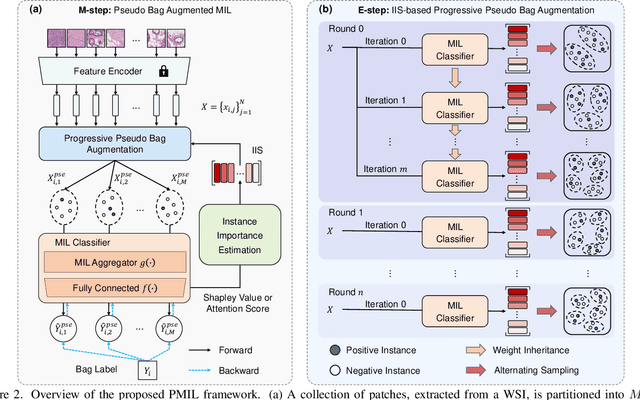

Abstract:In computational pathology, whole slide image (WSI) classification presents a formidable challenge due to its gigapixel resolution and limited fine-grained annotations. Multiple instance learning (MIL) offers a weakly supervised solution, yet refining instance-level information from bag-level labels remains complex. While most of the conventional MIL methods use attention scores to estimate instance importance scores (IIS) which contribute to the prediction of the slide labels, these often lead to skewed attention distributions and inaccuracies in identifying crucial instances. To address these issues, we propose a new approach inspired by cooperative game theory: employing Shapley values to assess each instance's contribution, thereby improving IIS estimation. The computation of the Shapley value is then accelerated using attention, meanwhile retaining the enhanced instance identification and prioritization. We further introduce a framework for the progressive assignment of pseudo bags based on estimated IIS, encouraging more balanced attention distributions in MIL models. Our extensive experiments on CAMELYON-16, BRACS, and TCGA-LUNG datasets show our method's superiority over existing state-of-the-art approaches, offering enhanced interpretability and class-wise insights. We will release the code upon acceptance.
 Add to Chrome
Add to Chrome Add to Firefox
Add to Firefox Add to Edge
Add to Edge